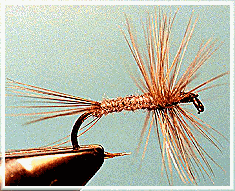Split Tails

Using the basic dry fly we learned last time as a reference pattern, we will expand on that learned skill to fan tails and split tails. We’ll also tie our first wing this week. Each fly is a stepping stone to the next fly. Each fly will add a new dimension to your tying skills.
I mentioned split tails last time. The advantage to split tails is increased buoyancy and balance. They also look a lot like the split tails that occur on mayflies. A twist on split tails is a fan tail.
Our first fly this time will have a fan tail. Otherwise, it’s the same fly as the one we tied last time. We’re just adding to what we already know. You are also going to learn how to use a rotary hackle plier.

Nothing matches a rotary hackle plier for speed and control once you’ve learned how and when to use one. I’ve tried several models of rotary hackle pliers and like the Griffin one far better than any of the others I’ve tried. It just holds the hackle better and rotates smoother than the rest. I believe I mentioned before that I’m a little unconventional at times.

Nothing matches a rotary hackle plier for speed and control once you’ve learned how and when to use one. I’ve tried several models of rotary hackle pliers and like the Griffin one far better than any of the others I’ve tried. It just holds the hackle better and rotates smoother than the rest. I believe I mentioned before that I’m a little unconventional at times.
Last week you learned the conventional method of wrapping hackle. This week we’ll try something new. Rotary hackle pliers are a little unconventional. Our second fly this week uses a method of wrapping hackle that’s even more unconventional. Hey, don’t run away just yet; it isn’t all that bad. Like I said before, I’ll try to pass on several ways to do the same thing if I can. Who knows, you might like the unconventional methods more than the conventional ones.
On with our first fly, a fan tailed gray dun. Of course, you can change colors to match a blue wing olive or Hendrickson if you wish; the steps remain the same. That’s the beauty of fly tying; you can often just change the materials to make a different fly. It will look different, but the steps used in tying it will be the same. Somehow, I think this puzzle just got a little easier to solve.
List of materials: Fan Tailed Gray Dun
Hook: Standard dry fly; Mustad 94840, Tiemco 100, Eagle Claw L059, Daiichi 1180. Size 10 - 22.
Hook: Standard dry fly; Mustad 94840, Tiemco 100, Eagle Claw L059, Daiichi 1180. Size 10 - 22.
Thread: 6/0 to 10/0 Gudebrod or equivalent, color to match body or black.
Body: Angler’s Choice pure silk dubbing, mink under-fur, muskrat under-fur, or any other synthetic or natural fine dubbing. Color to match the body of the insect you want to imitate.
Hackle: Quality neck or saddle hackle, webby parts removed and 1/16” of the remaining stem stripped of barbules. Color to match natural insect or any pattern you want to tie. (In this case, a gray dun.)
Many Thanks to Al Campbell
Happy Tying!
Ron

0 Comments:
Post a Comment
<< Home